We are in a small studio located at a musical instruments rental center on Sunset Boulevard, Los Angeles. The room is crammed with people sitting in rows of chairs in front of a low stage. On stage, Brad Sundberg, Michael Jackson’s assistant engineer and the organizer of this event, and his friend, sound engineer Brian Vibberts, are occupying two tall bar chairs. Brad Buxer, Michael long-time musical director is sitting behind a keyboard. MJ’s engineer of later years Michael Prince is looking at the screen of his MacBook. Michael’s touring bass guitarist Sam Simms has not yet arrived; he would join us a little bit later. With that, a trip to the past, full of stories and music, begins.
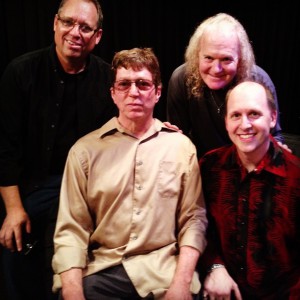 All guests of the event have a lot to tell about years spent working with Michael, but the “star” of this evening is clearly the man behind the keyboard. The event, after all, is called “Brad x2” and is all about meeting this guy who lives low-key and is barely known to the public outside of the fan community. Brad Buxer, Michael’s creative partner, arranger and musical director of 17 years. Most MJ fans would remember Buxer from the 90s as a guy with a mane of long Robert Plant-style blond hair. (Buxer confides that it was MJ who insisted that he dyed his hair blond — after giving up on the initial plan to get it colored red!) Well, those days are long gone. Today, Buxer wears short natural-color hair, black pants and a loose shirt, just like a regular guy who you’d never suspect to be a rock musician. He doesn’t talk about his work with Michael Jackson very often. In fact, since Michael’s passing, Buxer has given only one interview — to French fanzine “Black & White” in 2009. He now works as a professional pilot, and writing music is more of a hobby for him. He agreed to meet with MJ fans for one evening only, so for us this event is quite an exclusive treat.
All guests of the event have a lot to tell about years spent working with Michael, but the “star” of this evening is clearly the man behind the keyboard. The event, after all, is called “Brad x2” and is all about meeting this guy who lives low-key and is barely known to the public outside of the fan community. Brad Buxer, Michael’s creative partner, arranger and musical director of 17 years. Most MJ fans would remember Buxer from the 90s as a guy with a mane of long Robert Plant-style blond hair. (Buxer confides that it was MJ who insisted that he dyed his hair blond — after giving up on the initial plan to get it colored red!) Well, those days are long gone. Today, Buxer wears short natural-color hair, black pants and a loose shirt, just like a regular guy who you’d never suspect to be a rock musician. He doesn’t talk about his work with Michael Jackson very often. In fact, since Michael’s passing, Buxer has given only one interview — to French fanzine “Black & White” in 2009. He now works as a professional pilot, and writing music is more of a hobby for him. He agreed to meet with MJ fans for one evening only, so for us this event is quite an exclusive treat.
Buxer seems shy and soft-spoken at first, but we quickly realize that he is an outgoing and open guy. He doesn’t banter with fans like Brad Sundberg, and when he does joke, his jokes are more tongue-in-cheek. He starts off by telling us how he and Michael began working together. MJ spotted him as a member of Stevie Wonder’s band in the late 80s and invited him to work on the Dangerous project. After that, Buxer joined the Dangerous tour. They ended up working together for almost two decades – on stage, in studios, at Neverland, at hotels where Michael was staying at various points of his life.
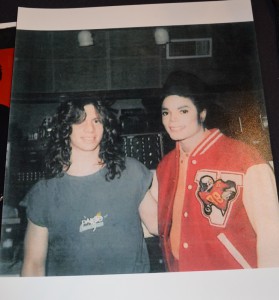
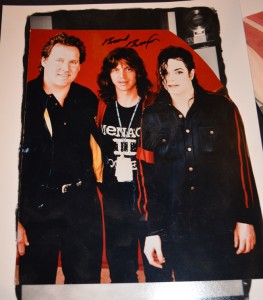
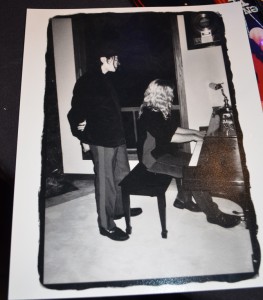
Brad Buxer’s personal photos with Michael
Buxer remembers their luxurious rooms at “4 Seasons” hotel in New York City where they took the entire 34th floor. He remembers spending time at Neverland ranch, seeing animals from Michael’s zoo – the monkeys, the elephants, the llamas and the deer, — eating too many candy bars at the movie theater and riding his motorbike on the edge of Michael’s swimming pool (a feat that made Michael freak out). Talking about Neverland ranch, Buxer mentions that there was no real recording studio there, and they had to use portable gear. They usually worked out song ideas at the ranch and then moved to a professional studio to do proper recoding.
After briefly touching on “Blood On the Dance Floor”, a Teddy Riley track that they had to recreate from a DAT cassette in Montreux, Switzerland, Buxer moves on to his and Michael’s personal collaborations. Unlike songs that were brought to Michael by other producers, songs that he did with Brad are Michael’s songs and contain the most of his artistic input.
The first track Brad chooses to talk about is “In the Back,” released on The Ultimate Collection in 2004. The song is not finished lyrically – for the most part, Michael ad-libs his way through the verses. Nevertheless, Buxer mentions this song as a testament to Michael’s genius. He demonstrates the song structure, starting to count bars, “One, two, three, four.” The first bar falls on the first bass beat, and as he counts all the way to the bridge, we notice that the bridge also starts on count “one,” as it should. The lyrics, however, are shifted against the music and don’t fit that pattern. Buxer describes this as “completely turned around” structure and talks about reversed up beat and down beat, but I’m not a musician and I can only refer to it as “a shift.” Buxer emphasizes that this song was written entirely by Michael. To prove his words, he lets us hear an audio of Michael explaining to him on the phone how exactly the music has to sound. In his usual manner, Michael relays each part with his voice and beatboxing: the drums, the bass, — and he is very particular in that. He spends about 5 minutes just to explain the intro to the song, and then asks, “Okay?” as if to make sure that the arranger has understood what is expected of him. Michael wrote the entire song with this “turned around” structure, says Buxer, and it shows right there what a genius he was. No one could do it but him.
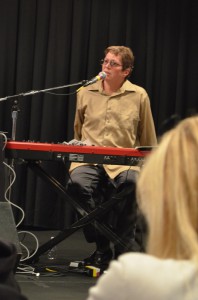 Then Buxer goes on to talk about “Stranger in Moscow.” This song contains his biggest contribution of all the material he worked on with Michael, and Brad doesn’t hide that it means a lot to him. He reads the entire piece about the song from Joe Vogel’s book – the story of the song creation is well documented by now. Even though Buxer is not credited in the album liner notes, he actually is a co-author of the song and the one who came up with the chords. Buxer explains that he and Michael could work together in two different ways. Oftentimes, Michael already had the melody in his head, and Buxer’s job was to play that melody on the keyboard as Michael was «hearing» it and find an arrangement that fit the melody. Such was their work on “Heal the World,” “In the Back,” “Childhood,” “Beautiful Girl” and other songs. With “Stranger in Moscow” it was different: Michael asked Brad to play chords until he would hear something he liked, and Buxer came up with the now famous chord progression. Buxer says that the entire song was written in about 1.5-2 hours, and when it was finished, he couldn’t believe what had just happened. “I wanted to say something, like, ‘Wow, did we just write a song together?’” recalls Buxer. “But I didn’t.” He doesn’t hold a grudge about not being credited on the album. “Mistakes happen,” he says. “Michael was always very generous to me.” It’s clear that the experience itself is much more important to him than his name in the booklet.
Then Buxer goes on to talk about “Stranger in Moscow.” This song contains his biggest contribution of all the material he worked on with Michael, and Brad doesn’t hide that it means a lot to him. He reads the entire piece about the song from Joe Vogel’s book – the story of the song creation is well documented by now. Even though Buxer is not credited in the album liner notes, he actually is a co-author of the song and the one who came up with the chords. Buxer explains that he and Michael could work together in two different ways. Oftentimes, Michael already had the melody in his head, and Buxer’s job was to play that melody on the keyboard as Michael was «hearing» it and find an arrangement that fit the melody. Such was their work on “Heal the World,” “In the Back,” “Childhood,” “Beautiful Girl” and other songs. With “Stranger in Moscow” it was different: Michael asked Brad to play chords until he would hear something he liked, and Buxer came up with the now famous chord progression. Buxer says that the entire song was written in about 1.5-2 hours, and when it was finished, he couldn’t believe what had just happened. “I wanted to say something, like, ‘Wow, did we just write a song together?’” recalls Buxer. “But I didn’t.” He doesn’t hold a grudge about not being credited on the album. “Mistakes happen,” he says. “Michael was always very generous to me.” It’s clear that the experience itself is much more important to him than his name in the booklet.
Another thing Buxer mentions about “Stranger in Moscow” is the drum sound that was made out of MJ’s beatboxing samples by slicing and compressing his natural sounds. Buxer says that with Michael, he used beatbox-based drum sounds quite often because they sounded fantastic.
The next song we discuss is “Childhood.” It is actually happening on the 20th anniversary of “Childhood” – as Brian Vibberts recalls it, the song was recorded on June 27, 1994. “Childhood” is another song that was envisioned and written entirely by Michael, and Buxer says that it took him a while to find the right arrangement for this one. “It’s such a sweet song,” he says. “I wouldn’t write anything so sweet.” But again, Michael was very particular about what he wanted to hear and continued to work with Buxer until he extracted exactly the right chords out of him.
After a short break, the discussion shifts to touring and live shows. Buxer describes for us the job of a musical director – how he often had to prepare for the shows beforehand while the band was spending time at the hotel bar downstairs, and how he used to give instructions to musicians. He explains that songs were usually sped up for the live shows, and then the pitch was lowered to bring the instruments back to their natural sound. He has very kind words for Michael’s guitar player David Williams who, he says, was absolutely brilliant and fun to be around. Buxer also touches on the subject of expenses and why live shows often lost money: the five airliners they had to contract for touring and the insane hotel bills.
Buxer remembers a couple of funny moments from the live concerts: how they had to push Slash out on stage during “Black or White” because he had no clue at what point in the song he was supposed to do his guitar solo, and how Michael called out Brad’s name (“Brad, what you gonna do?”) during the Royal Brunei concert when Buxer played the outro to “I Just Can’t Stop Loving You” longer than necessary. He also tells a story about Bill Clinton (according to Buxer, the nicest guy and a good friend to Michael) who wanted to play sax on “Black or White” during the live performance at the Apollo in 2002. Buxer even had to write a saxophone part for him — which didn’t really fit the song and ultimately wasn’t used.
Just as Brad Sundberg often points out, Buxer mentions that Michael listened to music excruciatingly loud. On stage, the volume of side-speakers was so high it was painful to be there between them. But Buxer, too, says that despite all this, he never noticed any loss of hearing in Michael. Michael liked his music deafening, but when Buxer played a delicate string arrangement to him over the phone, MJ could hear it just as well.
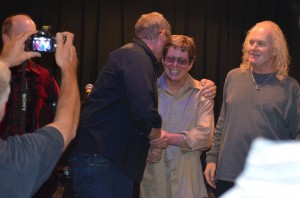 During the Q&A part, someone asked Buxer about song “Morphine” – another masterpiece ingeniously written by Michael. Buxer said that MJ wanted to have the sound of machines and the heartbeat, something that would conjure “a body on the table.”
During the Q&A part, someone asked Buxer about song “Morphine” – another masterpiece ingeniously written by Michael. Buxer said that MJ wanted to have the sound of machines and the heartbeat, something that would conjure “a body on the table.”
There were a couple of questions about the lyrics, but Buxer answered that he couldn’t even remember when the lyrics were written. It was often late in the process or even in the last moment, while the majority of the work was on music.
Maybe that was one of the reasons why Buxer, as most of Michael’s collaborators we had met, didn’t seem to enjoy the remixes and the new arrangements of Michael’s songs too much. “Michael was an architect [of the music],” he said. “If you want to see the building as it was envisioned, you have to keep the architect.” He mentioned “Billie Jean” – a song with two bass lines that Michael constructed intentionally. If someone else did the music to this song, opined Brad, they wouldn’t have done that. Michael worked on his songs for years, and he really put an effort to make the music as good as humanly possible. Sometimes, according to Buxer, Michael even criticized other artists for not working their songs to the fullest of their potential.
One thing Buxer emphasized throughout the conversation (and this is something that other colleagues of Michael’s often mention too) is the key principle in music that was followed by both Michael and Stevie Wonder: “Less is More.” The song should not be overstuffed with sounds; it should not have anything other than what fits and what makes the song better. To demonstrate his point, Buxer played a demo of “Hollywood Tonight” for us – the one with the killer bass part and Michael’s spoken instructions in the bridge. “Listen how pure it is.” And it was. The audience applauded.
His favorite memory of Michael? “Chasing each other through the halls of the hotel. He is a fast runner… Just hanging out, writing, working on his stuff, talking, laughing and just having a blast.”
Words like these make you realize more vividly than anything that for people like Brad Buxer and other guests of this seminar, Michael was not a superstar — he was a partner and a dear friend. And they came there that evening to share memories of their friendship. Thank you, Mr. Buxer, Mr. Prince, Mr. Vibberts and Mr. Simms for allowing us to hear those memories. And of course, a huge thanks to Mr. Brad Sundberg for organizing this one of a kind event.
The last minutes of the evening captured on video by one of the attendees:
Story by morinen
Photos (except the top one) by Maria Zhdanova
Thank you so much… that’s so great to read for all of us who couldn’t be there!
And thank you so much for all of us that WERE there! Such great memory and attention to detail!!!! I could have easily stayed and listened to them for days on end, it was such a warm, respectful and loving atmosphere. <3
Yes, thanks! This brings me wonderful memories of that evening (I was there), and how special it was. Thank you for the video, Veronica!
I hope to someday make it to one of these special sessions. How fortunate you all were to listen to Brad Buxer’s special memories. No doubt you will all remember this special time as a chance to come just a little closer to the mind of a true genius. God bless those who worked with him and considered him more than just a mega star—a real, dear friend and unforgettable man! My deepest thanks to all of you for sharing this precious account with us.
Actually, Brad (Buxer) misspoke in this clip. The piece he «embellished» is actually ‘Pavane Pour one infante défunte’ (‘Pavane for a Dead Princess») by Maurice Ravel, written in 1899. (If you look up ‘Pavane’ by Gabriel Fauré, you’ll find a different piece of music entirely.)
Wikipedia:
«Pavane pour une infante défunte (Pavane for a Dead Princess) is a well-known piece written for solo piano by the French composer Maurice Ravel in 1899 when he was studying composition at the Conservatoire de Paris under Gabriel Fauré. Ravel also published an orchestrated version of the Pavane in 1910. A typical performance of the piece lasts between six and seven minutes.»
Уведомление: Review: Brad x2 – Ein Abend mit Brad Buxer | all4michael
I was Michaeling this morning and found your review. I, too, attended the Sundberg seminar on Monday of that week and also the Bradx2 on Friday. Being a huge fan of Buxer for a long time made the time with him the highlight of my week. He was everything I imagined he would be and more. Besides being extraordinarily talented, he was warm, gracious, candid, fun and funny. He’s very understated about his relationship with Michael but it’s obvious he adored him and Michael him. Even more importantly, Michael could trust him and he’s never betrayed that trust and that is a rare thing….
PS — I took copious notes during the seminar but they are scribbled and sometimes incomplete so thank you for this.
My name is Morgan, when Brad was a member of the Jetzens in Phoenix I set up, tore down, and hauled all the equipment around from one gig to another for Brad and the rest of the group. We all roomed together at a «band house» in Mesa close to Merlin’s where the band played frequently. I haven’t seen Brad since the Jetzens disbanded and he moved to L.A. but I have lot of great memories from those early days and am happy to see how successful Brad’s career has turned out. Brad, if you see this, congrats on everything!
Morgan Morgan